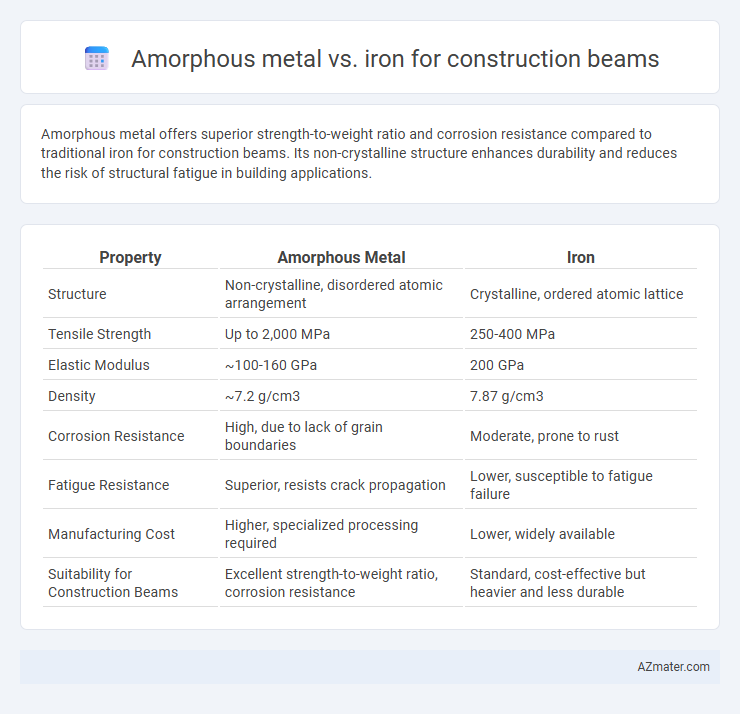Amorphous metal offers superior strength-to-weight ratio and corrosion resistance compared to traditional iron for construction beams. Its non-crystalline structure enhances durability and reduces the risk of structural fatigue in building applications.
Table of Comparison
| Property | Amorphous Metal | Iron |
|---|---|---|
| Structure | Non-crystalline, disordered atomic arrangement | Crystalline, ordered atomic lattice |
| Tensile Strength | Up to 2,000 MPa | 250-400 MPa |
| Elastic Modulus | ~100-160 GPa | 200 GPa |
| Density | ~7.2 g/cm3 | 7.87 g/cm3 |
| Corrosion Resistance | High, due to lack of grain boundaries | Moderate, prone to rust |
| Fatigue Resistance | Superior, resists crack propagation | Lower, susceptible to fatigue failure |
| Manufacturing Cost | Higher, specialized processing required | Lower, widely available |
| Suitability for Construction Beams | Excellent strength-to-weight ratio, corrosion resistance | Standard, cost-effective but heavier and less durable |
Introduction to Amorphous Metals and Iron in Construction
Amorphous metals, also known as metallic glasses, exhibit a non-crystalline atomic structure that offers exceptional strength, high corrosion resistance, and superior elasticity compared to traditional crystalline metals like iron. Iron, widely used in construction beams, provides high tensile strength, durability, and cost-effectiveness but is prone to corrosion and fatigue over time. The unique atomic arrangement of amorphous metals enables improved mechanical performance and longevity, making them a promising alternative to conventional iron in structural applications.
Material Structure: Amorphous Metals vs. Crystalline Iron
Amorphous metals, also known as metallic glasses, possess a disordered atomic structure that eliminates grain boundaries found in crystalline iron, resulting in higher strength and improved resistance to corrosion and fatigue. Crystalline iron, with its ordered lattice and distinct grain boundaries, is prone to stress concentration and corrosion at these interfaces, impacting durability. The non-crystalline structure of amorphous metals allows for superior elasticity and uniform deformation, making them advantageous for high-performance construction beams.
Mechanical Strength and Load-Bearing Capacity
Amorphous metal exhibits superior mechanical strength compared to traditional iron due to its non-crystalline atomic structure, which minimizes defects and enhances tensile strength. This characteristic allows amorphous metal beams to withstand higher stress and load-bearing capacities without deformation or failure. In construction, using amorphous metal beams can lead to lighter, stronger structures capable of supporting greater loads while improving durability and resistance to fatigue.
Corrosion Resistance and Durability
Amorphous metals exhibit superior corrosion resistance compared to traditional iron, due to their non-crystalline atomic structure which eliminates grain boundaries where corrosion typically initiates. This enhanced resistance extends the durability of construction beams in harsh environments, reducing maintenance costs and increasing lifespan. Iron beams, while strong and widely used, are more susceptible to rust and degradation, demanding protective coatings or treatments to improve their longevity.
Weight and Density Comparisons
Amorphous metals, also known as metallic glasses, exhibit a density typically ranging between 7.0 and 7.3 g/cm3, which is comparable to or slightly lower than that of standard iron, approximately 7.87 g/cm3. The lower density of amorphous metals contributes to reduced weight in construction beams, enhancing structural efficiency without compromising strength. This weight advantage makes amorphous metal beams highly suitable for applications requiring high strength-to-weight ratios, outperforming traditional iron in lightweight construction.
Fabrication and Manufacturing Processes
Amorphous metals, characterized by their non-crystalline atomic structure, require rapid cooling techniques such as melt spinning or high-pressure die casting for fabrication, contrasting with the traditional hot rolling and forging processes used for iron beams. The manufacturing of amorphous metal beams involves precise temperature control and advanced casting methods to maintain their unique properties, whereas iron beams undergo well-established heat treatment and welding procedures. These differences influence the scalability and cost-effectiveness of production, with amorphous metals offering superior strength-to-weight ratios but presenting challenges in large-scale beam fabrication compared to conventional iron materials.
Cost Analysis and Economic Feasibility
Amorphous metals, known for their superior strength-to-weight ratio and corrosion resistance, often have higher initial production costs compared to traditional iron used in construction beams due to complex manufacturing processes like rapid solidification. Despite the upfront expense, amortized lifecycle costs can be lower for amorphous metal beams because they require less maintenance and have longer service lives in corrosive environments. Economic feasibility improves in projects with high durability demands and maintenance constraints, where the reduced replacement frequency offsets the premium material cost over time.
Sustainability and Environmental Impact
Amorphous metals, characterized by their non-crystalline atomic structure, offer superior strength-to-weight ratios compared to traditional iron, reducing material demand and energy consumption in construction beam applications. Their enhanced corrosion resistance increases the lifespan of structural components, minimizing waste and the need for frequent replacements, contributing to sustainability. Iron, while abundant and recyclable, generally requires more energy-intensive processing and exhibits lower durability, leading to higher environmental impact over the lifecycle of construction materials.
Industry Applications and Adoption Trends
Amorphous metals offer superior strength-to-weight ratios and corrosion resistance compared to traditional iron, making them increasingly favored in high-performance construction beams for aerospace and advanced infrastructure projects. Industry adoption trends show growing investments in amorphous metal technologies due to their enhanced fatigue durability and magnetic properties, which improve structural efficiency and reduce long-term maintenance costs. Despite higher initial costs, the construction sector is progressively integrating amorphous metal beams to achieve sustainable and resilient building frameworks.
Future Prospects and Innovations in Construction Materials
Amorphous metals offer superior strength, corrosion resistance, and flexibility compared to traditional iron, making them promising candidates for next-generation construction beams. Innovations in alloy composition and manufacturing techniques are driving cost reductions and scalability, enabling wider adoption in structural applications. Future prospects include integration with smart construction technologies, enhancing durability and real-time structural health monitoring for safer, longer-lasting buildings.

Infographic: Amorphous metal vs Iron for Construction beam
 azmater.com
azmater.com